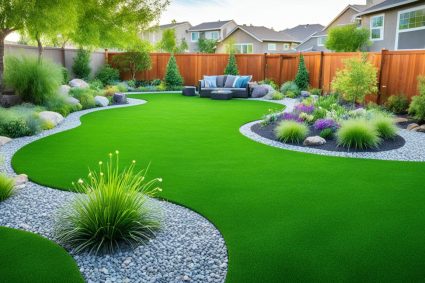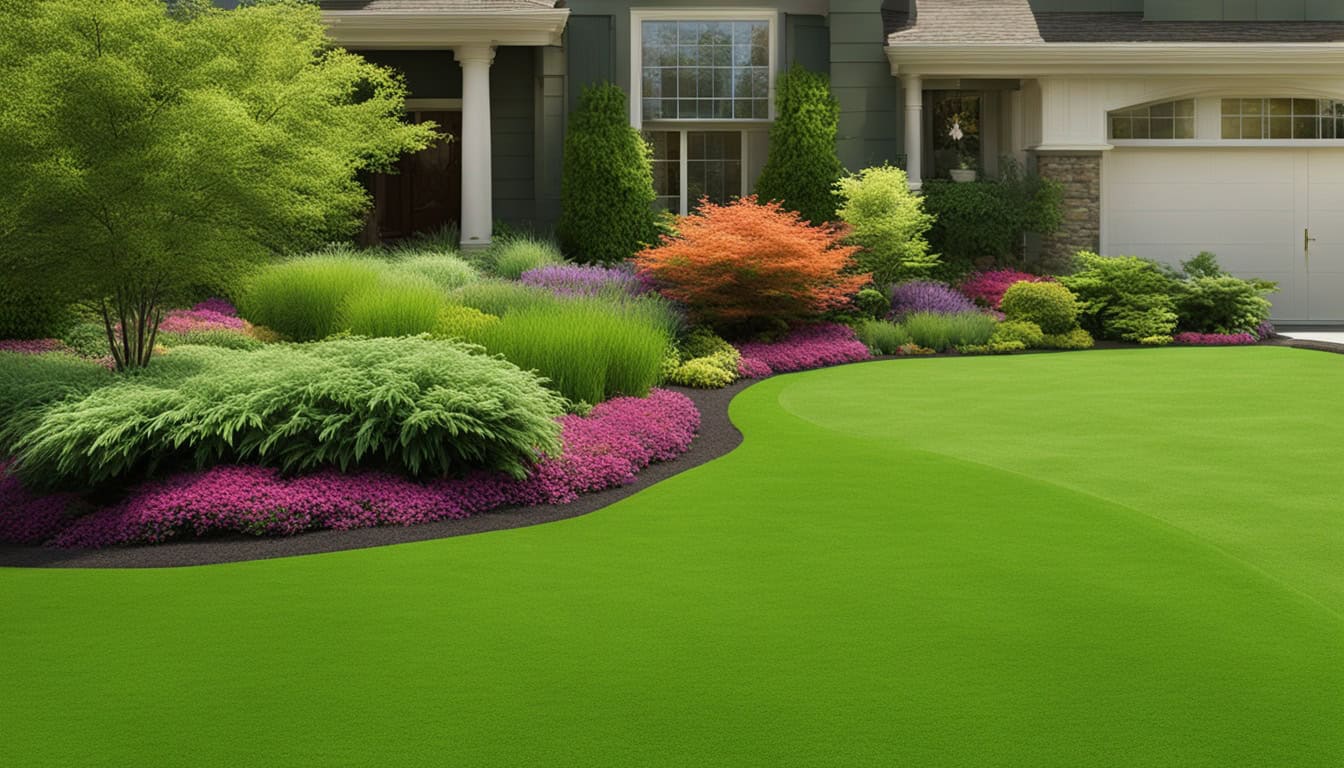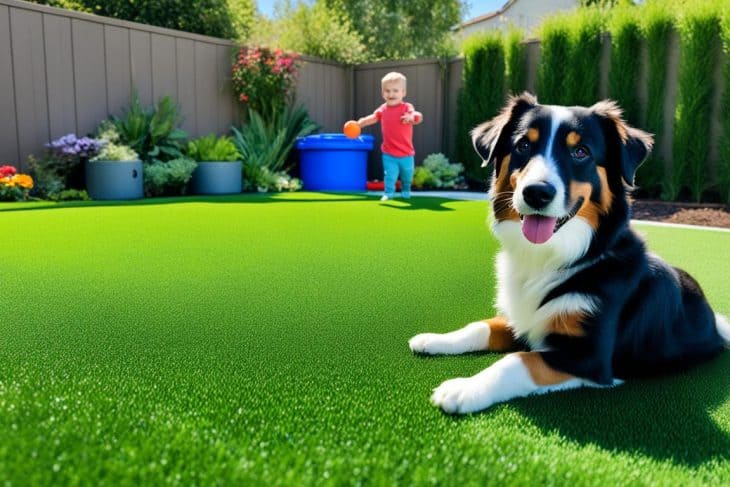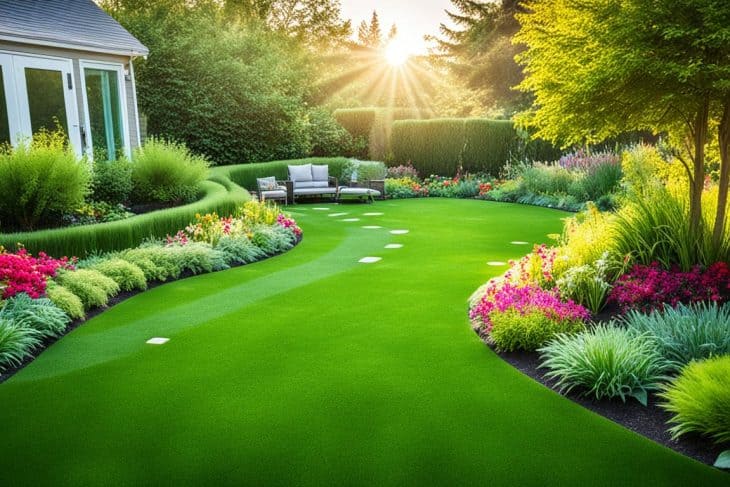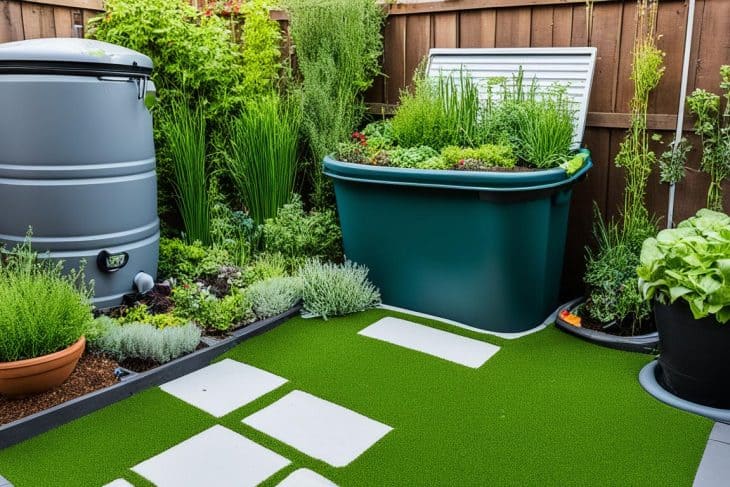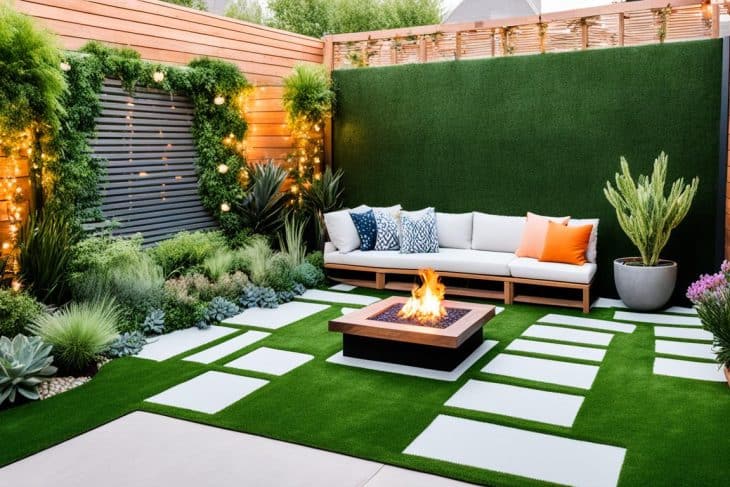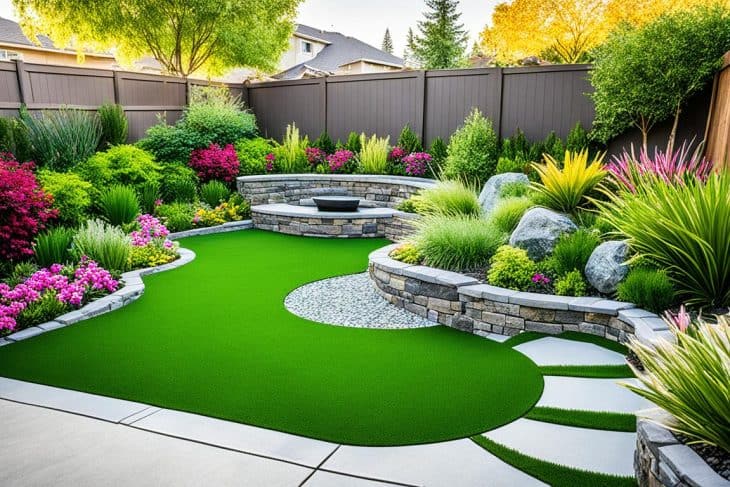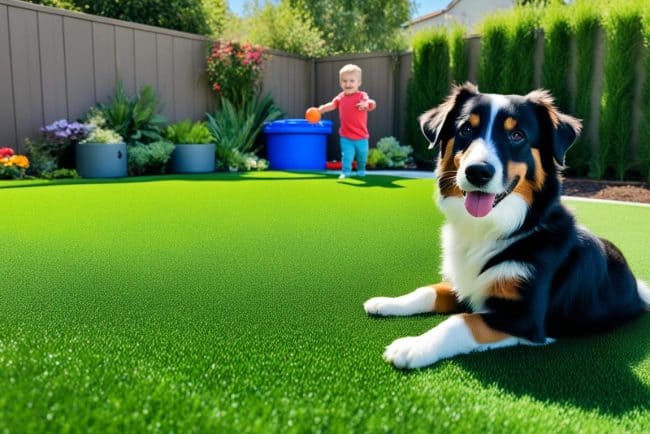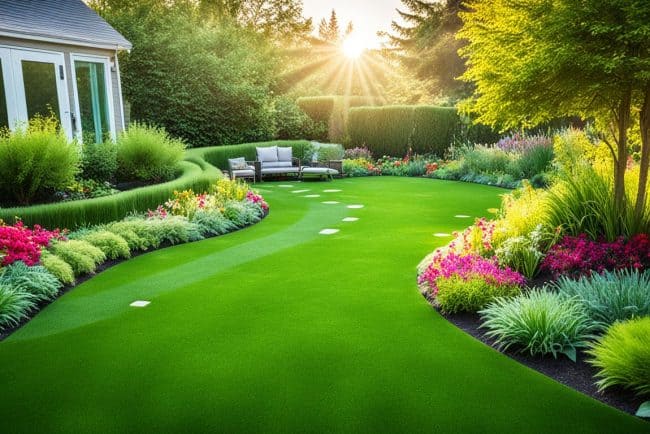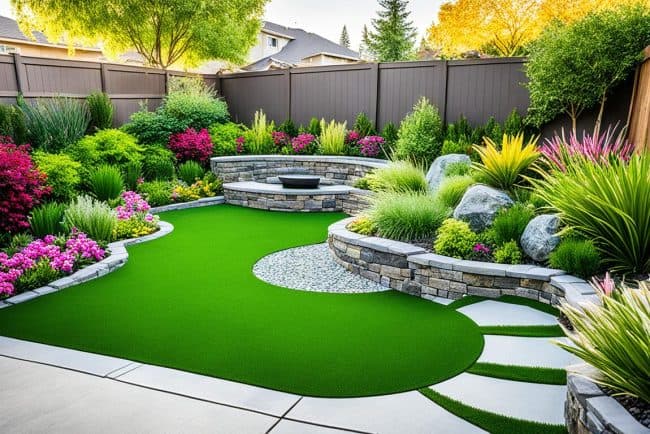
Did you know nearly one-third of all U.S. residential water use goes to landscape irrigation? That’s about 9 billion gallons each day. The average American household uses 320 gallons of water daily. Of that, 30% is for outdoor use, like keeping lawns green. As droughts hit harder, especially in California and the West, many are turning to eco-friendly artificial turf. This choice helps save water, cuts carbon emissions, and means less yard work.
SYNLawn and PolyTurf lead the way with synthetic grass that’s kind to the planet. These products don’t need fertilizers. So, they prevent harmful chemicals from running off into our water. Plus, they’re designed to last up to 20 years and are 100% recyclable. Choosing artificial grass means supporting sustainable land care and eco-friendly solutions.
Key Takeaways
- Artificial turf can significantly reduce residential water use, helping conserve thousands of liters annually.
- Brands like SYNLawn promote sustainability by manufacturing grass that requires no fertilizers or pesticides.
- Solutions like PolyTurf synthetic grass mitigate environmental impacts through reduced carbon emissions.
- Artificial lawns remain green even during drought conditions, eliminating the need for continual watering.
- Many eco-friendly grass options are made from recycled materials, promoting further sustainability.
- Switching to synthetic grass can help comply with LEED certification for green building projects.
Understanding Eco-Friendly Artificial Grass
I’ve recently gotten into sustainable landscaping. I’ve found that eco-friendly artificial grass is an awesome choice. It looks and feels just like real grass but doesn’t need much water or upkeep. It’s made from safe, plant-based stuff which is great for the planet and for us.
What is Eco-Friendly Artificial Grass?
Eco-friendly artificial grass uses things like sugar cane and soybean oil. This makes it a smart pick for your yard. If it’s USDA certified, you know it meets tough eco-standards. By choosing it, we help use less water, especially where water is scarce. And, we don’t need harmful chemicals to keep it looking good.
This kind of grass can last up to 25 years, making it a smart money move. It saves water and cuts down on gas-powered yard tools. Plus, it stays tough against bad weather, meaning less work to keep it nice.
Check out the benefits in this table:
| Feature | Eco-Friendly Artificial Grass | Natural Grass |
|---|---|---|
| Water Consumption | Significantly lower | High |
| Pesticide Use | None | Regular treatment required |
| Maintenance Frequency | Infrequent | High |
| Typical Lifespan | 25 years | 3-5 years |
| Environmental Impact | Lower emissions | Higher emissions |
Switching to eco-friendly artificial grass means we support farmers who grow the raw stuff. It makes our living spaces healthier, without allergens or environmental bad guys. And it looks amazing all year round.
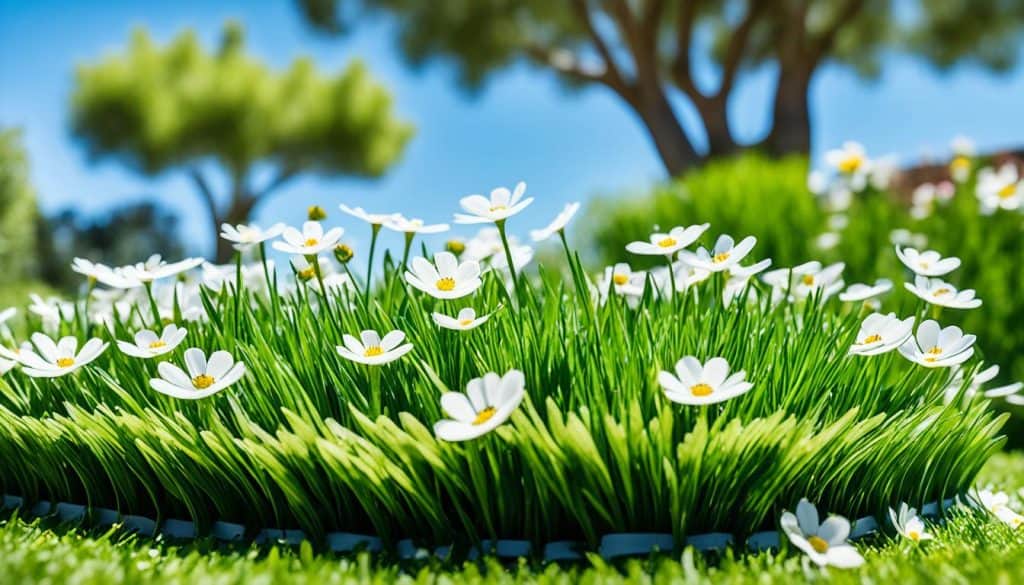
The Environmental Benefits of Artificial Turf
Switching to eco-friendly artificial grass comes with big environmental pluses. One major benefit is using less water. Unlike regular lawns, artificial turf hardly needs watering, just an occasional rinse. This is perfect for areas short on water. Did you know synthetic grass can save up to 22,000 gallons of water a year? This means lower water bills too.
There’s also a huge drop in chemical use. Artificial turf means no more need for pesticides, herbicides, or fertilizers. No chemicals makes for a healthier environment. I’ve seen firsthand how ditching these chemicals helps local nature. It also makes the grass safer for kids and pets.

Regular lawns need gas-powered machines for upkeep, which pollute the air. Synthetic grass cuts down on these carbon emissions. With no need for mowers or trimmers, we help the air stay cleaner. This makes for a healthier atmosphere.
Artificial turf lasts long, between 10 to 20 years, with hardly any upkeep. It’s not just tough but also cuts down on waste. Many turf products are even made from recycled materials. This choice in landscaping is definitely a win for sustainability.
Choosing artificial turf helps reduce landfill waste and supports better disposal practices. In California, efforts to fight climate change get a boost from such reduced waste. Picking eco-friendly options like synthetic grass helps people and businesses stay green. It also beautifies spaces.
Water Conservation with Eco-Friendly Turf
Keeping a green lawn usually means using a lot of water. This can harm the environment. But, eco-friendly turf changes the game. It needs little to no water, making it perfect for dry areas.
By choosing eco-friendly turf, you can cut down on your water bill. Traditional lawns need lots of water, but artificial grass doesn’t. Plus, it avoids the use of harmful chemicals. This helps protect our water and reduces harm to the environment.
Artificial grass helps stop soil from washing away. It’s great at absorbing water during heavy rains. The built-in drainage in eco-friendly turf also reduces water pollution.
Over time, artificial grass can cost less to maintain than real grass. It needs little upkeep and doesn’t need gas-powered tools. This means it’s also better for the air we breathe. As people learn about their impact on the planet, more are choosing sustainable lawns.
Choosing eco-friendly turf is a big step towards saving water and helping the environment. It’s made of high-quality, recycled materials. This supports a world where we reuse and recycle. Given its many benefits, artificial grass is a top choice for eco-conscious living.
Environmentally Friendly Solutions for Artificial Turf
Looking into green solutions for synthetic turf uncovers many innovative options. One is SYNLawn’s EnviroLoc Backing System. It uses renewable resources and cuts down on petroleum-based materials. Such green designs are part of a larger move toward eco-conscious landscaping products.
SYNRenew artificial turf is another great choice, with 60% of it made from soybeans. This turf looks like real grass but is much better for the planet. It cuts down greenhouse gas emissions by 71% using sugarcane. This makes its carbon footprint smaller than that of standard fuels. SYNRenew works well in places like front yards and pool decks.
Artificial turf greatly lowers water use. This means homeowners save on water and upkeep costs. Also, it gets rid of the need for gas-powered lawn tools. This decreases air pollution, fitting well with my eco-conscious decisions.
After installation, the perks of synthetic grass keep adding up. Products such as ProGreen artificial turf are 100% recyclable. This helps avoid waste in landfills since you don’t need regular lawn care products. Using artificial grass can even help you earn LEED credits. These credits are a high honor in eco-friendly building.
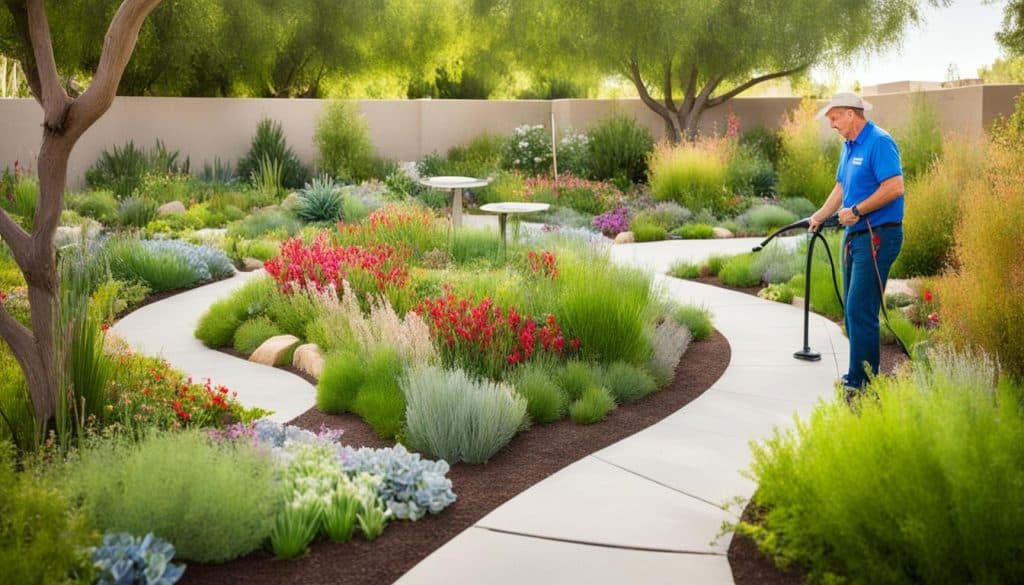
Reducing Carbon Emissions with Synthetic Grass
Switching to synthetic grass reduces carbon emissions. This change means less use of gas-powered lawn care tools. These tools pollute a lot.
For example, a gas-powered mower emits as much pollution as 11 cars in an hour. By choosing artificial turf, I lower my carbon footprint. This way, I get a green lawn all year without harming the planet.
The facts about synthetic grass reveal significant advantages. In the U.S., over 6,000 synthetic fields save a lot of water each year. For a normal-sized lawn, synthetic grass saves up to 99,000 gallons of water yearly. This choice not only conserves water but also avoids the use of dangerous chemicals.
While making synthetic grass produces some emissions, the benefits are clear. It stops lawn clippings and uses recycled materials. This helps make the planet healthier. Choosing synthetic grass shows we care about our earth’s future. It’s a smart move for a better world.

